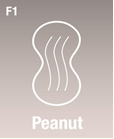Snakes, Peanuts, and Nano-movements!–June 25, 2015
Snakes, Peanuts, and Nano-movements!
The first of the nano-movements, PEANUT, is such a simple movement, yet we find many whose core movement doesn’t pass. Read on to learn more about this movement and how missing it may affect you.
Biology Basics
Cells are rapidly vibrating, expanding, and dividing. The mass of cells on their way to becoming an embryo grow in length before they begin to differentiate into the earliest structures.
At a microscopic level, movement is noticeable and appears like a beehive full of motion. Early ultrasound images reveal there are oscillatory movements taking place. We find this movement is similar to the slithering movement of a snake. Crazy how something so elementary yields the most essential ingredient to fluid movement for a child or adult.
Slithering Leads to Rolling
 The slithering movement seems to serve a purpose of aligning left and right rotational movements. When these rotations synchronize, a cylindrical rolling motion appears—similar to that of a peanut (and the DNA structure!) The peanut-like rolling motion sets the stage for all future rotational movements primarily found with the core and head.
The slithering movement seems to serve a purpose of aligning left and right rotational movements. When these rotations synchronize, a cylindrical rolling motion appears—similar to that of a peanut (and the DNA structure!) The peanut-like rolling motion sets the stage for all future rotational movements primarily found with the core and head.
The PEANUT nano-movement can be either missing or incomplete. The cause can be congenital, injury/illness, or both.
PEANUT Fail #1 Unbalanced Rotation
One of the ways we find this movement to be faulty is the rolling motion only goes in one direction. Surprisingly, there are some great athletes with this trait. They happen to compete in sports with a single rotational direction, such as golf and baseball. Overuse injuries are often when we meet someone with this fail.
PEANUT Fail #2 No Intrinsic Rotation
Yes, believe it or not, some people truly do not rotate. Often, they surprise you since these children and adults use self-generated motion to create the lacking sensory input associated with the missing intrinsic rotation. Dancers, gymnasts, and skaters often fall into the segment of perpetual motion machines!
Activity and repetitive movement can be used to substitute for either aspect of missing PEANUT. Look for rocking, swaying, or twirling movements. The sensory input provides a calming ingredient for the nervous system and its very important.
How Does Lack of PEANUT Affect You?
We often meet youth athletes when their excess movement impacts behavior or school performance. The typical traits are ADD, ADHD, and/or sensory seeking.
Adults often lose the ability to create their sustaining compensatory movements from injuries. This causes two issues—loss of the calming movement resulting in more agitation or anxiety than usual. The second issue is physical stress and stiffness due to the lack of ability to move in the core. When rotation is unbalanced there is often pain or unrelenting muscle tightness. When an injury is superimposed on this unbalanced movement, your body raises the white flag and there are simply no compensations left.
What Can Be Done?
We assess and check for the PEANUT nano-movement rotations. Then, we review your complete injury and developmental history for clues to put your movements back in place. If injury or illness are the cause this is relatively simple. Two to three Bridging® sessions often have you feeling great.
If there is a developmental aspect to your poor PEANUT, or slithering ability, we can still restore your movement. There are more steps involved but you usually begin to feel better right away.
How Can You Check PEANUT?
Watch our short video on the Kinetic Konnections YouTube channel to see the basics on checking for PEANUT at home. There can be some nuances which are tricky to interpret, but this should work for most of you. If checking your friends and family comes up short on rolling give us a call.
In case you are wondering how PEANUT nano-movement can get messed up, Scott will share his story related to movement challenges many years after being in a series of body casts.
From infants to adults, we restore your nano- and micro-movements quickly returning you to the movements that define your life!
Note from Cara
What could be better than kitten videos? Baby videos, of course!
I recently spent 3 ½ days in a course watching preemie and infant videos learning to assess the movement qualities of “at-risk” children.
Why, you might ask?
We find the clues to restoring nano-movements are buried in the richness of pre-natal movement and development. Better understanding of movement—good or not-so-good—helps to prioritize the movement gaps we see.
The best part of the course was learning the correlation between properly integrating core movement and nicely developing brains. We agree!!!
Hope you are finding ways to enjoy the outdoors between the rain!
